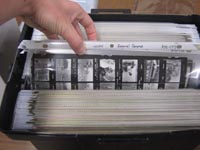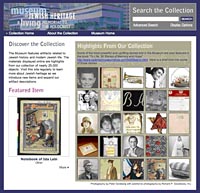- About Archives
- About SAA
- Careers
- Education
- Publications
- Advocacy
- Membership
By Erin Lawrimore
How are we informing our researchers about the record's creation, use, and relationship to other materials? How are we assisting in piecing together the contextual pieces to build a greater archival puzzle? The 2009 Description Expo focuses on innovation in conveying contextual information through archival description.
![]()
George Mason University Libraries Special Collections & Archives
Beginning in February 2009, the processing archivist, Jordan Patty, worked on creating a Google Custom Search feature for both the Special Collections & Archives website and the finding aids. Previously, staff created EAD finding aids as XML files and stored them on a Web server that was invisible to Google. Also, there was not a search feature to search all of the finding aids. Once the processing archivist and digital collections archivist, Bob Vay, had completed testing the Google Custom Search feature, the processing archivist uploaded finding aids to the website and placed the HTML pages in a dedicated folder. As the processing archivist uploaded new finding aids to the sca.gmu.edu/finding_aids/ folder, the digital collections archivist included those HTML page links in the Google Custom Search inventory.
Google Custom Search allows each HTML finding aid to be indexed and specific folders to be designated for refined searches. The use of the custom search provides full text keyword searching across 130 finding aids and increases the page ranking in the larger Google Search. SC&A staff continues to create EAD finding aids in XML, but they are now converted to HTML prior to uploading to the website. Although the search capabilities are not optimized by converting to HTML, the Google Custom Search keyword feature provides adequate results and was easy to implement compared to the installation of a more sophisticated system using XML and a database. There is a search box on the SC&A homepage http://sca.gmu.edu/ and the results appear on a separate page http://sca.gmu.edu/search_results.html that includes hyperlink to refine the searches for finding aids when the keyword search results are returned. To find out more about Google Custom Search, see http://www.google.com/coop/cse/.

OhioLINK EAD FACTORy (EAD Finding Aid Creation Tool & Repository)
The Repository is designed to showcase the rich collections housed in archives, libraries, and other institutions throughout the state of Ohio. It is on the DLXS platform. The encoding tool, a Web-based wizard, was developed jointly by members of the OhioLINK EAD Task Force and Kent State University Libraries and Media Services, Systems Unit staff. Programming was completed by David Gaj, Applications Developer, Kent State University Libraries. See an overview and sample screens. Specifications and content standards for the Tool were developed by members of the EAD Task Force. All institutions in Ohio are welcome to use the encoding tool and/or add finding aids to the Repository.

Archives of American Art, Smithsonian Institution
EAD Finding Aids Used for Online Presentation of Fully Digitized Collections
Collections Online is an online resource at the Archives of American Art that solves the archival puzzle of how to provide access to collections that are digitized in their entirety. The solution rests upon utilizing the collection's EAD finding aid and providing access to the digitized documents through folder level access. More (pdf) and documentation on the SI site.

University of California, Irvine Libraries Special Collections and Archives
Processing Historical Photographs
In process is at the University of California, Irvine Libraries Special Collections and Archives is a photograph collection from UCI's Communications Office. The photographs document the entire history of the University and are in constant use. The collection includes 92 linear feet of slides, negatives, prints, and contact sheets. Over the years several archivists, and students worked piecemeal on the collection, and a recent accession doubled its size. Various finding aids, inventories, charts, training manuals, and databases were created to help reference staff locate materials, but access remained confusing and limited at best. My job is to cohesively process the whole collection and build an easy to use comprehensive access system to gain intellectual and physical control over the materials. More (pdf).

Museum of Jewish Heritage
The Online Collection: A Living Memorial to the Holocaust
The Online Collection expands public education about the Holocaust and Jewish Heritage by browsing artifacts and discovering their interconnections in a dynamic and user-friendly online environment. This web resource facilitates browsing though a collection of approximately 9,000 artifacts by employing a largely visual display. Many of the artifacts in the Online Collection have never been displayed and are available only on this website. The Museum is in a continuing process of placing the remaining 16,000 artifacts in the collection online, as well as new artifacts from Holocaust survivors, liberators, immigrants, and their families. More (pdf).
Home | Annual Reports | Standing Rules | Description Expo | Descriptive Notes | Minutes | Reports & Presentations | Section Leadership